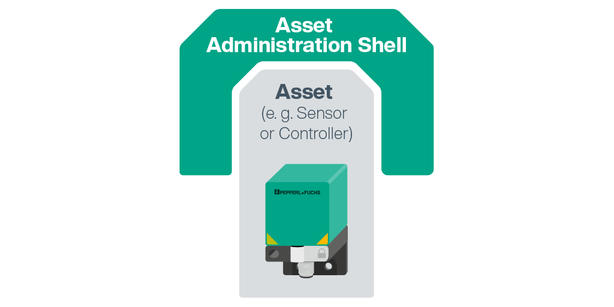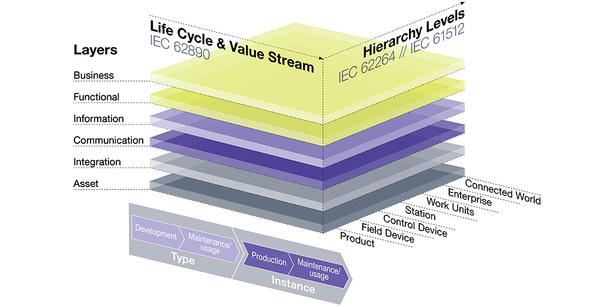
Digitizing Industrial Supply Chains in Medium-Sized Companies
Our contribution to Manufacturing-X
Shaping the Industry 4.0 Data Space
The next stage of Industry 4.0: With the "Manufacturing-X" initiative, German "Plattform Industrie 4.0" is creating a sovereign data space across industries and companies—with the aim of enabling multilateral cooperation along supply chains and taking digital value creation processes to a new level.
As a company that contributed to Industry 4.0 from the very beginning, for example by working on the Reference Architecture Model Industry 4.0 (RAMI) Pepperl+Fuchs is now actively participating in the next evolutionary step as part of Manufacturing-X: Our expertise focuses on the intelligent use of various technologies and standards for end-to-end digital collaboration within a data ecosystem.

Pepperl+Fuchs has been a continuous supporter of Industry 4.0 from the beginning and understands how to implement digitalization from the shop floor to the office floor.

Our portfolio covers various sensor and interface technologies plus the corresponding software and integration know-how.

Whether in discrete manufacturing or process plants—with customers in virtually every industry, we have decades of experience that we can leverage in Manufacturing-X.

From IEC 61406, IEC 63278, VDI 2770, IEC 62264 or IEC 62890 to knowledge in explosion protection and functional safety—our contribution to Manufacturing-X is based on a deep understanding of various regulations and standards.
Asset Administration Shell (AAS)

We believe that the realization of a cross-company and cross-industry data space such as Manufacturing-X requires standardized virtual representations of all physical or digital assets in the value chains. For this reason, we consider the Asset Administration Shell (AAS) to be the most future-proof and promising approach for implementing digital twins in the sense of Industry 4.0: Its secure, standardized and machine-readable format enables interoperability between solutions from different providers. This makes it a crucial tool for the implementation of digital nameplates, digital product passports, or decentralized registers.
Concepts
Reference Architectural Model Industrie 4.0 (RAMI 4.0)

Digital collaboration within the data ecosystem of Manufacturing-X requires standards and structures that regulate the flow of data. Among others, Pepperl+Fuchs played a key role in the development of the RAMI 4.0 model, which charts a clear path for a digitally networked future of industry and production systems. As a 3-D map, it forms the basis for the development and implementation of Industry 4.0 concepts by describing the communication between both, simple components, such as field devices, and entire factories. This framework provides a guideline for aligning the many simultaneous Industry 4.0 activities and is the central reference point for our activities in the Manufacturing-X initiative.
Technologies

Identification Technologies as the Foundation of the Data Space
Powerful sensor technology that reliably handles tasks along the production line, such as object and position detection, are used as a basis for automated control of production processes. However, reaching the next stage of development for a data ecosystem like Manufacturing-X is not just about ensuring physical production assets such as raw materials, semi-finished goods, and end products go through the manufacturing process without complications.
A consistent and standardized representation ("digital twin") of these objects in the virtual space forms the basis for a higher degree of transparency and supply chain resilience, as well as further digital value creation. To connect to these digital twins, all physical assets must be carry unique identifiers that can be applied directly to objects using various optically readable code symbologies (e.g., barcodes, Data Matrix codes, QR codes) or in the form of RFID tags.

omlox Facilitates Cross-Site Dynamics
If identification technologies form the foundation of the Manufacturing-X data space, omlox brings in the dynamics: This recently released, open, and interoperable standard for industrial localization supports further transformation toward fully digitalized and paperless processes. For the first time, it offers plug-and-play interoperability across a variety of technologies, including UWB, Wi-Fi, GPS, 5G, RFID, and Bluetooth. Combining all these technologies within the framework of omlox creates a completely continuous information flow that extends far beyond the factory doors in a way that has never been done before.
For example, trucks equipped with RFID read/write devices that have been modified to meet the omlox standard can query the status and location of specific goods via GSM and 5G directly during transport. This information increases transparency and resilience in supply chains: Once the information is transferred to higher-level software systems such as ERP and MES, it allows for a reaction to potential transport delays and for downstream processes to be adapted.

Increased Data for the Process Industry
In addition, the vision of Manufacturing-X is to encompass the process industry—and meet the special conditions it requires. On the one hand, the dimensions of plants and the associated long cable paths represent a challenge for transferring larger amounts of data.
On the other hand, this industry has requirements in terms of electrical explosion protection that must be observed at all times. Balancing these conditions, however, is an area of great potential that could be tapped with the intelligent use of various infrastructure technologies and smart communication devices.

Digital Access to Product Information
Electrical explosion protection also had a serious impact on the current definition of a digital nameplate or "identification link": The requirement to make legally prescribed device markings—which are becoming increasingly complex—electronically detectable ultimately resulted in IEC 61406, which also covers non-hazardous areas. The standardized identifier at the instance level, i.e., a unique identifier for each serial number, makes it possible to link manufacturer information such as servicing and maintenance plans to the product instances.
By using suitable systems, individual components in a plant can be quickly and easily identified using mobile devices. The required information can be accessed anytime, anywhere, at all process levels, and throughout the product life cycle—creating another important communication path within the Manufacturing-X digital data space.

An Enabler of Information Exchange
With the introduction of the new EU Corporate Sustainability Reporting Directive (CSRD) alongside supply chain regulations and the requirement for digital product passports, an efficient communication infrastructure is more important than ever. Creating this infrastructure in manufacturing companies is a task that Pepperl+Fuchs subsidiary Neoception has committed itself to fulfilling: The Neoception® Digital Twin Infrastructure offers an innovative solution for smooth and efficient communication across the entire supply chain.
It helps companies establish accurate and reliable reporting in accordance with the standards of the Industry 4.0 platform, through which they can meet current expectations as to responsible and sustainable practices. Neoception has long been a member of standardization organizations and has networked intensively with partners such as VDI/VDE, ECLASS, and IDTA—these actions form the basis of this technology.
Bize Ulaşın
 More Information
More Information
- Manufacturing-X at Plattform Industrie 4.0 Mission statement by Plattform Industrie 4.0 on the goals and purposes of the initiative.
- Neoception Visit the homepage of Pepperl+Fuchs' IIoT subsidiary Neoception.




 +90 216 577 2250
+90 216 577 2250